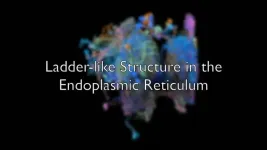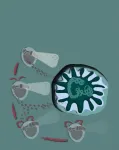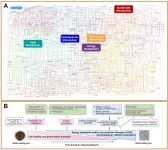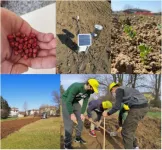(Press-News.org) Our biceps and our brain cells may have more in common than previously thought.
New research led by the Lippincott-Schwartz Lab shows that a network of subcellular structures similar to those responsible for propagating molecular signals that make muscles contract are also responsible for transmitting signals in the brain that may facilitate learning and memory.
“Einstein said that when he uses his brain, it is like he is using a muscle, and in that respect, there is some parallel here,” says Janelia Senior Group Leader Jennifer Lippincott-Schwartz. “The same machinery is operating in both cases but with different readouts.”
The first clue about the possible connection between brain and muscle cells came when Janelia scientists noticed something strange about the endoplasmic reticulum, or ER – the membranous sheets and folds inside cells that are crucial for many cellular functions.
Lorena Benedetti, a research scientist in the Lippincott-Schwartz Lab, was tracking molecules at high resolution along the surface of the ER in mammalian neurons when she saw that the molecules were tracing a repeating, ladder-like pattern along the entire length of the dendrites -- the branch-like extensions on brain cells that receive incoming signals.
Around the same time, Senior Group Leader Stephan Saalfeld alerted Lippincott-Schwartz to high-resolution 3D electron microscopy images of neurons in the fly brain where the ER was also forming regularly spaced, transversal structures.
The ER normally appears like a huge, dynamic net, so as soon as Lippincott-Schwartz saw the structures, she knew her lab needed to figure out what they were for.
“In science, structure is function,” says Lippincott-Schwartz, who also heads Janelia’s 4D Cellular Physiology research area. “This is an unusual, beautiful structure that we are seeing throughout the whole dendrite, so we just had this feeling that it must have some important function.”
The researchers, led by Benedetti, started by looking at the only other area of the body known to have similar, ladder-like ER structures: muscle tissue. In muscle cells, the ER and the plasma membrane – the outer membrane of the cell – meet at periodic contact sites, an arrangement controlled by a molecule called junctophilin.
Using high-resolution imaging, the researchers discovered that dendrites also contain a form of junctophilin that controls contact sites between their ER and plasma membrane. Further, the team found that the same molecular machinery controlling calcium release at muscle cells’ contact sites — where calcium drives muscle contraction — was also present at dendrite contact sites — where calcium regulates neuronal signaling.
Because of these clues, the researchers had a hunch that the molecular machinery at the dendritic contact sites must also be important for transmitting calcium signals, which cells use to communicate. They suspected that the contact sites along the dendrites might act like a repeater on a telegraph machine: receiving, amplifying, and propagating signals over long distances. In neurons, this could explain how signals received at specific sites on dendrites are relayed to the cell body hundreds of micrometers away.
“How that information travels over long distances and how the calcium signal gets specifically amplified was not known,” says Benedetti. “We thought that ER could play that role, and that these regularly distributed contact sites are spatially and temporally localized amplifiers: they can receive this calcium signal, locally amplify this calcium signal, and relay this calcium signal over a distance.”
The researchers found that this process is triggered when a neuronal signal causes calcium to enter the dendrite through voltage-gated ion channel proteins, which are positioned at the contact sites. Although this initial calcium signal dissipates quickly, it triggers the release of additional calcium from the ER at the contact site.
This influx of calcium at the contact site attracts and activates a kinase called CaMKII, a protein known to be important in memory. CaMKII alters the plasma membrane’s biochemical properties, changing the strength of the signal that is passed down the plasma membrane.
This process continues from contact site to contact site all along the dendrite to the cell body, where the neuron decides how it will communicate with other neurons.
The new research reveals a novel mechanism for signal transmission in brain cells and helps answer an open question in neuroscience about how intracellular signals travel over long distances in neurons, enabling information received at specific sites on dendrites to be processed in the brain.
It also sheds light on the molecular mechanisms underlying synaptic plasticity – the strengthening or weakening of neuronal connections that enables learning and memory. Figuring out this process at the molecular level could increase understanding of how the brain works normally and in diseases where these processes go awry, like Alzheimer’s.
“We are showing that a structure – a beautiful structure – operating at a level of subcellular organization is having a huge effect on the way the entire neuronal system is operating vis-à-vis calcium signaling,” Lippincott-Schwartz says. “This is a great example of how, in doing science, if you see a beautiful structure, it can take you into a whole new world.”
END
From muscle to memory: new research uses clues from the body to understand signaling in the brain
2025-02-07
ELSE PRESS RELEASES FROM THIS DATE:
New study uncovers key differences in allosteric regulation of cAMP receptor proteins in bacteria
2025-02-07
Washington, D.C. – A new study, “Identifying Allosteric Hotspots in Mycobacterium tuberculosis cAMP Receptor Protein” published in Biochemistry, provides key insights into how bacterial cAMP receptor proteins (CRPs) respond differently to the ubiquitous signaling molecule, cyclic AMP (cAMP). By comparing the allosteric regulation of Escherichia coli CRP (CRPEcoli) and Mycobacterium tuberculosis CRP (CRPMTB), researchers challenge the assumption that structural similarity predicts functional behavior in allosteric proteins.
This ...
Co-located cell types help drive aggressive brain tumors
2025-02-07
A type of aggressive, treatment-resistant brain tumor has a distinct population of immune cells that support its growth, according to new research led by investigators at the Johns Hopkins Kimmel Cancer Center Bloomberg~Kimmel Institute for Cancer Immunotherapy and the Johns Hopkins University School of Medicine.
Searching for subtypes of immune cells seen only in the most serious, grade 4 brain tumors, called glioblastomas, and using a recently developed technology called spatial genomics, ...
Social media's double-edged sword: New study links both active and passive use to rising loneliness
2025-02-07
"The Epidemic of Loneliness: A Nine-Year Longitudinal Study of the Impact of Passive and Active Social Media Use on Loneliness" investigated how social media use impacts loneliness over time. This eye-opening research suggests that the very platforms designed to bring us together contribute to an "epidemic of loneliness."
The findings showed that both passive (PSMU) and active (ASMU) social media use were associated with increased feelings of loneliness over time. While passive social media use—like browsing without ...
An unexpected mechanism regulates the immune response during parasitic infections
2025-02-07
Researchers at the University of Liège (Belgium) have uncovered a previously unknown mechanism that regulates the immune response against parasites. During a parasitic infection, specific immune cells, known as virtual memory T cells (TVM), become activated and express a surface molecule called CD22, which prevents an excessive immune reaction. This discovery could help in better-controlling inflammation and improving immune responses to infections.
Nearly a quarter of the world's population ...
Scientists enhance understanding of dinoflagellate cyst dormancy
2025-02-07
Dinoflagellates play crucial roles in aquatic ecosystems, particularly as major contributors to harmful algal blooms. They can enter a dormant stage, known as the resting cyst stage, that allows them to survive for extended periods—up to 150 years—in marine sediments. This dormancy is essential for their annual population dynamics, blooming cycles, and geographic expansion.
Despite the ecological importance of resting cysts, the molecular mechanisms governing their dormancy, viability maintenance, and germination in natural sediments remain largely unexplored.
To better understand this process, researchers from the Institute of Oceanology, Chinese Academy of Sciences ...
PREPSOIL promotes soil literacy through education
2025-02-07
One of the eight key aims of the EU Mission Soil is to enhance soil literacy in society. As part of this effort, the PREPSOIL project is working to inspire teachers across Europe to integrate soil topics into their teaching. By identifying and promoting innovative examples of soil education, PREPSOIL aims to empower educators to engage students in exploring the vital role of soil in natural, urban, and agricultural environments.
In 2023 and 2024, teachers were invited to submit their best practices in soil education targeting primary, secondary, and vocational students. The initiative received over 50 submissions, showcasing a variety of creative and interdisciplinary ...
nTIDE February 2025 Jobs Report: Labor force participation rate for people with disabilities hits an all-time high
2025-02-07
East Hanover, NJ – February 7, 2024 – The latest National Trends in Disability Employment (nTIDE) report revealed a record-breaking Labor Force Participation Rate for people with disabilities, marking an all-time high. These gains build upon a steady upward trend, which exceeded those seen among people without disabilities. nTIDE is issued by Kessler Foundation and the University of New Hampshire’s Institute on Disability (UNH-IOD).
Month-to-Month nTIDE Numbers (comparing December 2024 to January 2025)
Based on data from the ...
Temperamental stars are distorting our view of distant planets
2025-02-07
Most of the information we have about planets beyond our solar system (exoplanets) comes from looking at dips in starlight as these planets pass in front of their host star.
This technique can give clues about the planet’s size (by looking at how much starlight is blocked) and what its atmosphere is made of (by looking at how the planet changes the pattern of starlight that passes through it).
But a new study, published in The Astrophysical Journal Supplement Series, concluded that fluctuations in ...
DOE’s Office of Science is now Accepting Applications for Office of Science Graduate Student Research Awards
2025-02-07
Washington, D.C. – The U.S. Department of Energy’s (DOE) Office of Science is pleased to announce that the Office of Science Graduate Student Research (SCGSR) program is now accepting applications for the 2025 solicitation 1 cycle. Applications are due on Wednesday, May 7, 2025, at 5:00 p.m. ET.
SCGSR application assistance workshops will be held on March 6, 2025, 2:00 p.m.–3:30 p.m. ET and April 10, 2025, 2:00 p.m.–4:30 p.m. ET. The first workshop ...
Twenty years on, biodiversity struggles to take root in restored wetlands
2025-02-07
While the restoration of natural areas is high on political agendas, a comprehensive new study from the University of Copenhagen shows that – after more than two decades – biodiversity growth has stalled in restored Danish wetlands. The results also suggest that time alone will not heal things because the areas are too small and dry, and nitrogen inputs from agriculture continue. According to the researchers, we need to learn from the past.
The benefits are clear: natural areas with high biodiversity absorb ...





